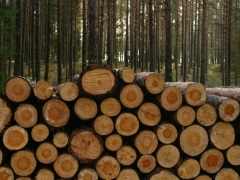Features
Can’t see the wood for the trees
Date: 2018-03-26 10:49:50.0
Author: Jon Evans

As wood pellets are increasingly being burnt to generate electricity in power stations, especially in Europe, so concerns are increasingly being raised that burning wood pellets could actually make global warming worse.
As with biofuels, the supposed advantage of wood pellets is that the growth of new trees can absorb the carbon dioxide released by burning the pellets, producing no overall increase in atmospheric carbon dioxide levels. This makes wood pellets ‘carbon neutral’, but only over long enough timescales, because it obviously takes years for growing trees to absorb the carbon dioxide emitted by the pellets. In the short term, just like burning coal, burning pellets adds carbon dioxide to the atmosphere.
Looking into this process in more detail, researchers are now realising that it’s not quite as simple as first appears. They are finding that burning pellets actually produces more carbon dioxide than originally thought and that the conditions required to absorb all the emitted carbon dioxide can be difficult to achieve.
Many of these issues were highlighted in a study conducted by researchers led by John Sterman at the MIT Sloan School of Management, US. They developed a model to analyze the release of carbon dioxide from burning wood pellets, compared to burning coal. The model was based on the existing Climate Rapid Overview and Decision Support (C-ROADS) simulator, which Sterman and his colleagues expanded to cover different land and land-use types by regions. This allowed them to model stocks of carbon in fossil fuels, biomass, soil, dead organic matter and the atmosphere, and the flow between then caused by combustion, supply chain emissions and the growth of new trees.
As reported in a paper in Environmental Research Letters, they applied the model to the specific case of European power stations burning wood pellets produced from forests in the US, as 7 million tonnes of pellets are currently shipped from the US to Europe every year. This revealed that because wood is a less efficient fuel than coal and because of the energy required to transport the wood pellets from the US to Europe, wood pellets actually emit more carbon dioxide per generated kilowatt hour than coal
Even if all this carbon dioxide is subsequently absorbed by growing trees, it can still cause damage in the short term, especially if it takes the environment over some tipping point that can’t easily be reversed. However, the model also shows how difficult it is for all the emitted carbon dioxide to be absorbed by growing trees. For a start, this takes a long time, with the model predicting that the carbon dioxide emitted from wood pellets takes between 44 years and 104 years to be absorbed, depending on the wood.
Hardwood takes the longest time to repay its carbon debt, because hardwood trees are slow growing. If the hardwood trees are replaced by faster-growing species such as pine, however, the debt is never fully repaid, because pine trees don’t sequester as much carbon dioxide. The situation is even worse if the growing pine is repeatedly cut down after 20 years, as tends to happen with commercially-grown pine, because the original debt from hardwood is never repaid at all. This is also the case if the former hardwood forest is converted to another use, such as cropland or housing.
These concerns are echoed in a recent article in Science written by William Schlesinger from the Cary Institute of Ecosystem Studies in Millbrook, US, but he adds another concern as well. That is the effect on wildlife of cutting down established hardwood forests, due to the destruction of valuable ecosystems. Again, pine doesn’t provide an adequate replacement, because pine trees don’t support as much biodiversity as hardwood forests.
All is not lost, however, because other forms of biomass, like energy grasses such as switchgrass, can be burnt to produce power without the problems of wood pellets. For energy grasses grow much faster and are harvested much more regularly, so they pay back their carbon debt within a year. There is also much scope for growing energy grasses in Europe, rather than having to transport them all the way from the US (see Buy British biomass).
The views represented here are solely those of the author and do not necessarily represent those of John Wiley and Sons, Ltd. or of the SCI.
Displaying 1 keywords used to tag this article:
- 5170J-001 - Yellow Gold - Men Compl
